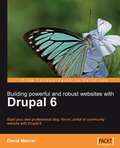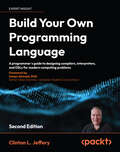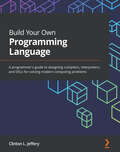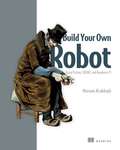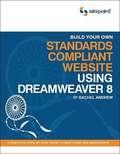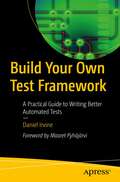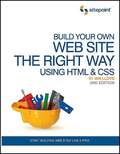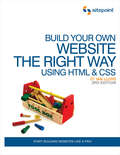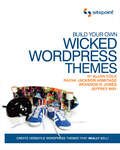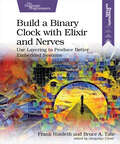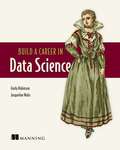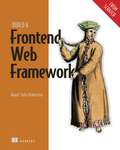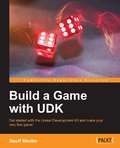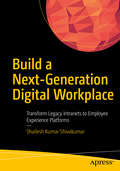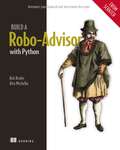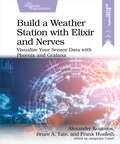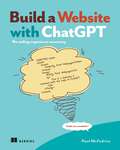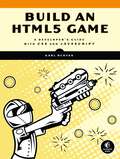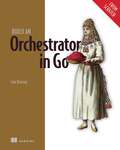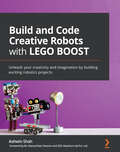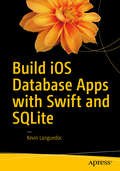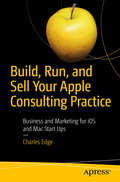- Table View
- List View
Build Your Own Professional Blog, Forum, Portal or Community Website with Drupal 6
by David MercerDescription of how to design and build a web site using the Drupal CMS tool.
Build Your Own Programming Language: A programmer's guide to designing compilers, interpreters, and DSLs for modern computing problems
by Clinton L. JefferyLearn to design your own programming language in a hands-on way by building compilers, using preprocessors, transpilers, and more, in this fully-refreshed second edition, written by the creator of the Unicon programming language. Purchase of the print or Kindle book includes a free PDF eBookKey FeaturesTakes a hands-on approach; learn by building the Jzero language, a subset of Java, with example code shown in both the Java and Unicon languagesLearn how to create parsers, code generators, scanners, and interpretersTarget bytecode, native code, and preprocess or transpile code into a high-level languageBook DescriptionThere are many reasons to build a programming language: out of necessity, as a learning exercise, or just for fun. Whatever your reasons, this book gives you the tools to succeed. You’ll build the frontend of a compiler for your language and generate a lexical analyzer and parser using Lex and YACC tools. Then you’ll explore a series of syntax tree traversals before looking at code generation for a bytecode virtual machine or native code. In this edition, a new chapter has been added to assist you in comprehending the nuances and distinctions between preprocessors and transpilers. Code examples have been modernized, expanded, and rigorously tested, and all content has undergone thorough refreshing. You’ll learn to implement code generation techniques using practical examples, including the Unicon Preprocessor and transpiling Jzero code to Unicon. You'll move to domain-specific language features and learn to create them as built-in operators and functions. You’ll also cover garbage collection. Dr. Jeffery’s experiences building the Unicon language are used to add context to the concepts, and relevant examples are provided in both Unicon and Java so that you can follow along in your language of choice. By the end of this book, you'll be able to build and deploy your own domain-specific language.What you will learnAnalyze requirements for your language and design syntax and semantics.Write grammar rules for common expressions and control structures.Build a scanner to read source code and generate a parser to check syntax.Implement syntax-coloring for your code in IDEs like VS Code.Write tree traversals and insert information into the syntax tree.Implement a bytecode interpreter and run bytecode from your compiler.Write native code and run it after assembling and linking using system tools.Preprocess and transpile code into another high-level languageWho this book is forThis book is for software developers interested in the idea of inventing their own language or developing a domain-specific language. Computer science students taking compiler design or construction courses will also find this book highly useful as a practical guide to language implementation to supplement more theoretical textbooks. Intermediate or better proficiency in Java or C++ programming languages (or another high-level programming language) is assumed.
Build Your Own Programming Language: A programmer's guide to designing compilers, interpreters, and DSLs for solving modern computing problems
by Clinton L. JefferyWritten by the creator of the Unicon programming language, this book will show you how to implement programming languages to reduce the time and cost of creating applications for new or specialized areas of computingKey FeaturesReduce development time and solve pain points in your application domain by building a custom programming languageLearn how to create parsers, code generators, file readers, analyzers, and interpretersCreate an alternative to frameworks and libraries to solve domain-specific problemsBook DescriptionThe need for different types of computer languages is growing rapidly and developers prefer creating domain-specific languages for solving specific application domain problems. Building your own programming language has its advantages. It can be your antidote to the ever-increasing size and complexity of software.In this book, you'll start with implementing the frontend of a compiler for your language, including a lexical analyzer and parser. The book covers a series of traversals of syntax trees, culminating with code generation for a bytecode virtual machine. Moving ahead, you'll learn how domain-specific language features are often best represented by operators and functions that are built into the language, rather than library functions. We'll conclude with how to implement garbage collection, including reference counting and mark-and-sweep garbage collection. Throughout the book, Dr. Jeffery weaves in his experience of building the Unicon programming language to give better context to the concepts where relevant examples are provided in both Unicon and Java so that you can follow the code of your choice of either a very high-level language with advanced features, or a mainstream language.By the end of this book, you'll be able to build and deploy your own domain-specific languages, capable of compiling and running programs.What you will learnPerform requirements analysis for the new language and design language syntax and semanticsWrite lexical and context-free grammar rules for common expressions and control structuresDevelop a scanner that reads source code and generate a parser that checks syntaxBuild key data structures in a compiler and use your compiler to build a syntax-coloring code editorImplement a bytecode interpreter and run bytecode generated by your compilerWrite tree traversals that insert information into the syntax treeImplement garbage collection in your languageWho this book is forThis book is for software developers interested in the idea of inventing their own language or developing a domain-specific language. Computer science students taking compiler construction courses will also find this book highly useful as a practical guide to language implementation to supplement more theoretical textbooks. Intermediate-level knowledge and experience working with a high-level language such as Java or the C++ language are expected to help you get the most out of this book.
Build Your Own Robot: Using Python, CRICKIT, and Raspberry PI
by Marwan AlsabbaghA DIY guide to bringing your first robot to life with cheap and basic components.Build Your Own Robot introduces you to the exciting world of robotics in a way that&’s fun and affordable! You&’ll build your own real robot with easy-to-find hardware and free open source software. Plus, all the components you need can be assembled with simple tools like a screwdriver. In Build Your Own Robot you&’ll learn how to: Use cameras to capture photos and let your robot see Add cameras and basic computer vision Coordinate DC motors to move your robot Write a web app to control your robot Set up controls for joysticks Read QR codes to find and identify objects This book shows you how anyone can start building their own robot—no special soldering or electronic skills required. All you need is some basic Python know-how to get started. From scratch, you&’ll go hands-on with DC motors, touch sensors, custom shell scripting, joystick controls, and even face detection for your robot friend. About the technology You can build your own robot! With this book, you&’ll use readily-available hardware and author Marwan Alsabbagh&’s clear step-by-step instructions to create a robot that moves, manipulates objects, and responds to its environment. Along the way, you&’ll learn some serious skills like computer vision, networking, and the basics of robotics programming. About the book Build Your Own Robot is a project-based guide that takes you from spinning your first DC motor to programming a mobile robot that you can control from your phone or computer. You&’ll write simple Python code to help your new friend spin, move, and find its way. You&’ll even teach it to track faces and fetch snacks. Plus, a helpful hardware purchasing guide makes it easy to find exactly what you need to get started! What's inside Coordinate DC motors to move your robot Write a web app to control your robot Adding cameras and basic computer vision Read QR codes to find and identify objects About the reader Examples use simple Python code. No special skills or expensive tools required. About the author Marwan Alsabbagh is a seasoned software developer, who has studied mathematics and computer science at McGill University. The technical editor on this book was Alexander Ryker. Table of Contents 1 What is a robot? 2 Getting started 3 Driving the robot 4 Creating a robot shell 5 Controlling robots remotely 6 Creating robot web apps 7 Joystick-controlled robots 8 Keyboard-controlled camera 9 Face-following camera 10 Robotic QR code finder 11 Building a snack-pushing robot A Hardware purchasing guide B Configuring the Raspberry Pi C Robot assembly guide D Mocking the CRICKIT library
Build Your Own Standards Compliant Website Using Dreamweaver 8
by Rachel AndrewBuild Your Own Standards Compliant Website with Dreamweaver 8 is written for any user of Dreamweaver who wants to create standards compliant, usable and fully accessible websites. By applying Web Standards and best-practices, readers will learn to create fast-loading, easy-to-maintain and cross-browser compatible Websites. This book focuses on using XHTML and semantic markup, CSS Layouts, and accessibility guidelines to show users how to make the most of Dreamweaver 8.
Build Your Own Test Framework: A Practical Guide to Writing Better Automated Tests
by Daniel IrvineLearn to write better automated tests that will dramatically increase your productivity and have fun while doing so. This book is a build-your-own adventure designed for individual reading and for collaborative workshops. You will build an xUnit automated test framework using JavaScript: initially a clone of Jest, but adding a couple of neat features borrowed from RSpec, the genre-defining tool for behavior-driven development (BDD). Along the way, you will explore the philosophy behind automated testing best practices. The automated test runner is one of the most important innovations within software engineering. But for many programmers, automated testing remains a mystery, and knowing how to write good tests is akin to sorcery.As the chapters of this book unfold, you will see how the humble test runner is an elegant and simple piece of software. Each chapter picks a single feature to build, like the "it" function or the "beforeEach" block. It picks apart the theory of why the feature needs to exist, and how to use it effectively in your own test suites. Every chapter ends with a set of ideas for extension points should you wish to explore further, alone or in groups. The book culminates in an implementation of test doubles and mocks—one of the most difficult and misunderstood concepts within automated testing.By the end of the book, you will have gained a solid understanding of automated testing principles that you can immediately apply to your work projects. What You'll LearnBuild an xUnit automated test frameworkSee how an automated test runner worksUnderstand the best practices for automated unit testingEffectively use test doubles and mocksWho This Book Is ForSoftware developers with JavaScript experience who are seeking to master the art of automated testing.
Build Your Own Web Site the Right Way Using HTML & CSS (2nd Edition)
by Ian LloydBuild Your Own Website The Right Way Using HTML & CSS, 2nd Edition teaches web development from scratch, without assuming any previous knowledge of HTML, CSS or web development techniques. This book introduces you to HTML and CSS as you follow along with the author, step-by-step, to build a fully functional web site from the ground up. However, unlike countless other "learn web design" books, this title concentrates on modern, best-practice techniques from the very beginning, which means you'll get it right the first time. The web sites you'll build will: Look good on a PC, Mac or Linux computer Render correctly whether your visitors are using Internet Explorer, Firefox, Opera, or Safari Use web standards so your sites will be fast loading and easy to maintain Be accessible to disabled users who use screen readers to browse the Web By the end of the book, you'll be equipped with enough knowledge to set out on your first projects as a professional web developer, or you can simply use the knowledge you've gained to create attractive, functional, usable and accessible sites for personal use.
Build Your Own Website The Right Way Using HTML & CSS: Start Building Websites Like a Pro!
by Ian LloydWith over 60,000 copies sold since its first edition, this SitePoint best-seller has just had a fresh update to include recent advances in the web industry.With the first two editions coming highly recommended by established, leading web designers and developers, the third edition with all its extra goodies will continue that trend. Also fully updated to include the latest operating systems, web browsers and providing fixes to issues that have cropped up since the last edition.Readers will learn to:Style text and control your page layout with CSSCreate and Optimize graphics for the WebAdd interactivity to your sites with formsInclude a custom search, contact us page, and a News/Events section on your siteTrack visitors with Google AnalyticsExtend your reach and connect your site with Social MediaUse HTML5&CSS3 to add some cool, polished features to your siteUse diagnosis/debug tools to find any problemsAnd lots more.
Build Your Own Website: A Comic Guide to HTML, CSS, and WordPress
by Nate CooperBuild Your Own Website is a fun, illustrated introduction to the basics of creating a website. Join Kim and her little dog Tofu as she learns HTML, the language of web pages, and CSS, the language used to style web pages, from the Web Guru and Glinda, the Good Witch of CSS.Once she figures out the basics, Kim travels to WordPress City to build her first website, with Wendy, the WordPress Maven, at her side. They take control of WordPress® themes, install useful plugins, and more.As you follow along, you’ll learn how to:–Use HTML tags–Make your site shine with CSS–Customize WordPress to fit your needs–Choose a company to host your site and get advice on picking a good domain nameThe patient, step-by-step advice you’ll find in Build Your Own Website will help you get your website up and running in no time. Stop dreaming of your perfect website and start making it!
Build Your Own Wicked Wordpress Themes: Create Versatile Wordpress Themes That Really Sell!
by Alan Cole Raena Jackson Armitage Brandon R. Jones Jeffrey WayWicked WordPress Themes is a step-by-step guide to creating beautiful themes for the world's most popular CMS, WordPress.By following the book's advice, readers can produce designs that are aesthetically stunning, consistent, and for-purpose -whether it's for their own use, or to drive a high price on the theme marketplace.All facets of theme design are covered: from design, coding, and deployment, to ensuring readers' designs are ready-to-go as soon as they're installed. Wicked WordPress Themes teaches readers how to leverage theme design frameworks to dramatically shorten development time, enabling them to enter the theme market faster.
Build a Binary Clock with Elixir and Nerves
by Bruce Tate Frank HunlethWant to get better at coding Elixir? Write a hardware project with Nerves. As you build this binary clock, you'll build in resiliency using OTP, the same libraries powering many commercial phone switches. You'll attack complexity the way the experts do, using a layered approach. You'll sharpen your debugging skills by taking small, easily verified steps toward your goal. When you're done, you'll have a working binary clock and a good appreciation of the work that goes into a hardware system. You'll also be able to apply that understanding to every new line of Elixir you write. Combining software with hardware can be frustrating, but you can become proficient in no time by taking a simple, logical approach. Blinking a single LED is the traditional "hello-world" of embedded systems. Building your own binary clock is the logical next step. It blinks groupings of LEDs based on the system time. This guide walks you through a working project using the techniques used by experts who build software for hardware every day. This common sense project moves forward in tiny, logical steps. As you progress, you can verify each step before moving on to the next. You don't have to be a Nerves novice to benefit from this project. Become a better Elixir programmer as you build your own desktop showpiece. With a layered approach to software design, you'll learn to control the complexity of your programs the way the experts do by focusing on one small slice of your system at a time. When you're done, you'll have your own binary clock, and also more of the tools you need to design and build your own Nerves and Elixir projects. You'll also be a better programmer with a deeper appreciation of layering techniques for controlling complexity. What You Need: This project is for Elixir developers who want to get started with Nerves, or improve their skills. The project is designed for Elixir 1.11 and Nerves 1.7, but later versions will probably work as well with slight modifications. The project uses a Raspberry Pi zero with a set of components. With slight modifications, you can make this book work with other components as well.
Build a Career in Data Science
by Emily Robinson Jacqueline NolisSummary You are going to need more than technical knowledge to succeed as a data scientist. Build a Career in Data Science teaches you what school leaves out, from how to land your first job to the lifecycle of a data science project, and even how to become a manager. Purchase of the print book includes a free eBook in PDF, Kindle, and ePub formats from Manning Publications. About the technology What are the keys to a data scientist&’s long-term success? Blending your technical know-how with the right &“soft skills&” turns out to be a central ingredient of a rewarding career. About the book Build a Career in Data Science is your guide to landing your first data science job and developing into a valued senior employee. By following clear and simple instructions, you&’ll learn to craft an amazing resume and ace your interviews. In this demanding, rapidly changing field, it can be challenging to keep projects on track, adapt to company needs, and manage tricky stakeholders. You&’ll love the insights on how to handle expectations, deal with failures, and plan your career path in the stories from seasoned data scientists included in the book. What's inside Creating a portfolio of data science projects Assessing and negotiating an offer Leaving gracefully and moving up the ladder Interviews with professional data scientists About the reader For readers who want to begin or advance a data science career. About the author Emily Robinson is a data scientist at Warby Parker. Jacqueline Nolis is a data science consultant and mentor. Table of Contents: PART 1 - GETTING STARTED WITH DATA SCIENCE 1. What is data science? 2. Data science companies 3. Getting the skills 4. Building a portfolio PART 2 - FINDING YOUR DATA SCIENCE JOB 5. The search: Identifying the right job for you 6. The application: Résumés and cover letters 7. The interview: What to expect and how to handle it 8. The offer: Knowing what to accept PART 3 - SETTLING INTO DATA SCIENCE 9. The first months on the job 10. Making an effective analysis 11. Deploying a model into production 12. Working with stakeholders PART 4 - GROWING IN YOUR DATA SCIENCE ROLE 13. When your data science project fails 14. Joining the data science community 15. Leaving your job gracefully 16. Moving up the ladder
Build a Frontend Web Framework (From Scratch)
by Ángel Sola OrbaicetaLearn how a frontend web framework works by coding your own!Web developers use frontend frameworks every day—but do you know how these essential parts of your stack really work? Build a Frontend Web Framework (From Scratch) reveals the inner workings of web frameworks by helping you create your very own. In Build a Frontend Web Framework (From Scratch), you&’ll learn the secrets behind frameworks like React, Vue, and Angular, including: Create HTML documents programmatically Define the view with virtual DOM Update the HTML efficiently with reconciliation algorithms Create two-way communication mechanisms between components in a hierarchy Whatever your experience level, you&’ll be able to start building your framework with this guide. All you need is some core skills in HTML, CSS, and JavaScript. And once you&’ve learned how frameworks function, you&’ll be able to work with them more efficiently, troubleshoot bugs more effectively, and even customize them for your specific needs! About the technology You use frontend frameworks every day, but do you really know what&’s going on behind the API? Building your own framework is a great way to learn how they interact with the DOM, generate page views, route data between components, and communicate with the underlying operating system. With this interesting and entertaining book, you&’ll build your own web framework step-by-step in JavaScript, ready to share with the world as an NPM package! About the book Build a Frontend Web Framework (From Scratch) guides you through a simple component-based frontend framework that borrows from React, Svelte, Angular, and other familiar tools. You&’ll learn how a modern framework operates by adding features like component state and lifecycle management, a virtual DOM, and reconciliation algorithms to update the HTML efficiently. You&’ll appreciate how each critical concept is broken down into easy-to-digest chunks and explained with engaging graphics. What's inside Create HTML documents programmatically Define the view with the virtual DOM Implement a component lifecycle scheduler About the reader For web developers familiar with JavaScript and Node. About the author Angel Sola Orbaiceta has worked in the software industry for over a decade, creating software for the cloud, macOS, and Windows desktop applications. Table of Contents PART 1 1 Are frontend frameworks magic to you? 2 Vanilla JavaScript—like in the old days PART 2 3 Rendering and the virtual DOM 4 Mounting and destroying the virtual DOM 5 State management and the application&’s lifecycle 6 Publishing and using your framework&’s first version 7 The reconciliation algorithm: Diffing virtual trees 8 The reconciliation algorithm: Patching the DOM PART 3 9 Stateful components 10 Component methods 11 Subcomponents: Communication via props and events 12 Keyed lists 13 The component lifecycle hooks and the scheduler 14 Testing asynchronous components Appendix
Build a Game with UDK
by Geoff ShollerA step-by-step tutorial to create an astounding game using the tools provided by UDK.This book is intended for people who aim to make an amazing virtual game with UDK. The goal of this book to give users a chance to expand their knowledge and create exciting games using the tools available.
Build a Large Language Model (From Scratch)
by Sebastian RaschkaLearn how to create, train, and tweak large language models (LLMs) by building one from the ground up!In Build a Large Language Model (from Scratch) bestselling author Sebastian Raschka guides you step by step through creating your own LLM. Each stage is explained with clear text, diagrams, and examples. You&’ll go from the initial design and creation, to pretraining on a general corpus, and on to fine-tuning for specific tasks. Build a Large Language Model (from Scratch) teaches you how to: • Plan and code all the parts of an LLM • Prepare a dataset suitable for LLM training • Fine-tune LLMs for text classification and with your own data • Use human feedback to ensure your LLM follows instructions • Load pretrained weights into an LLM Build a Large Language Model (from Scratch) takes you inside the AI black box to tinker with the internal systems that power generative AI. As you work through each key stage of LLM creation, you&’ll develop an in-depth understanding of how LLMs work, their limitations, and their customization methods. Your LLM can be developed on an ordinary laptop, and used as your own personal assistant. About the technology Physicist Richard P. Feynman reportedly said, &“I don&’t understand anything I can&’t build.&” Based on this same powerful principle, bestselling author Sebastian Raschka guides you step by step as you build a GPT-style LLM that you can run on your laptop. This is an engaging book that covers each stage of the process, from planning and coding to training and fine-tuning. About the book Build a Large Language Model (From Scratch) is a practical and eminently-satisfying hands-on journey into the foundations of generative AI. Without relying on any existing LLM libraries, you&’ll code a base model, evolve it into a text classifier, and ultimately create a chatbot that can follow your conversational instructions. And you&’ll really understand it because you built it yourself! What's inside • Plan and code an LLM comparable to GPT-2 • Load pretrained weights • Construct a complete training pipeline • Fine-tune your LLM for text classification • Develop LLMs that follow human instructions About the reader Readers need intermediate Python skills and some knowledge of machine learning. The LLM you create will run on any modern laptop and can optionally utilize GPUs. About the author Sebastian Raschka, PhD, is an LLM Research Engineer with over a decade of experience in artificial intelligence. His work spans industry and academia, including implementing LLM solutions as a senior engineer at Lightning AI and teaching as a statistics professor at the University of Wisconsin–Madison. Sebastian collaborates with Fortune 500 companies on AI solutions and serves on the Open Source Board at University of Wisconsin–Madison. He specializes in LLMs and the development of high-performance AI systems, with a deep focus on practical, code-driven implementations. He is the author of the bestselling books Machine Learning with PyTorch and Scikit-Learn, and Machine Learning Q and AI. The technical editor on this book was David Caswell. Table of Contents 1 Understanding large language models 2 Working with text data 3 Coding attention mechanisms 4 Implementing a GPT model from scratch to generate text 5 Pretraining on unlabeled data 6 Fine-tuning for classification 7 Fine-tuning to follow instructions A Introduction to PyTorch B References and further reading C Exercise solutions D Adding bells and whistles to the training loop E Parameter-efficient fine-tuning with LoRA
Build a Next-Generation Digital Workplace: Transform Legacy Intranets to Employee Experience Platforms
by Shailesh Kumar ShivakumarEvolve your traditional intranet platform into a next-generation digital workspace with this comprehensive book. Through in-depth coverage of strategies, methods, and case studies, you will learn how to design and build an employee experience platform (EXP) for improved employee productivity, engagement, and collaboration.In Build a Next-Generation Digital Workplace, author Shailesh Kumar Shivakumar takes you through the advantages of EXPs and shows you how to successfully implement one in your organization. This book provides extensive coverage of topics such as EXP design, user experience, content strategy, integration, EXP development, collaboration, and EXP governance. Real-world case studies are also presented to explore practical applications.Employee experience platforms play a vital role in engaging, empowering, and retaining the employees of an organization. Next-generation workplaces demand constant innovation and responsiveness, and this book readies you to fulfill that need with an employee experience platform.You will:Understand key design elements of EXP, including the visual design, EXP strategy, EXP transformation themes, information architecture, and navigation design.Gain insights into end-to-end EXP topics needed to successfully design, implement, and maintain next-generation digital workplace platforms.Study methods used in the EXP lifecycle, such as requirements and design, development, governance, and maintenanceExecute the main steps involved in digital transformation of legacy intranet platforms to EXP.Discover emerging trends in digital workplace such as gamification, machine-led operations model and maintenance model, employee-centric design (including persona based design and employee journey mapping), cloud transformation, and design transformation.Comprehend proven methods for legacy Intranet modernization, collaboration, solution validation, migration, and more.Who This Book Is ForDigital enthusiasts, web developers, digital architects, program managers, and more.
Build a Robo-Advisor with Python (From Scratch)
by Rob ReiderTake control of your wealth management by building your own reliable, effective, and automated financial advisor tool.Automated digital financial advisors—also called robo-advisors—manage billions of dollars in assets. Follow the step-by-step instructions in this hands-on guide, and you&’ll learn to build your robo-advisor capable of managing a real investing strategy. In Build a Robo-Advisor with Python (From Scratch) you&’ll learn how to: • Measure returns and estimate the benefits of robo-advisors • Use Monte Carlo simulations to build and test financial planning tools • Construct diversified, efficient portfolios using optimization and other methods • Implement and evaluate rebalancing methods to track a target portfolio over time • Decrease taxes through tax-loss harvesting and optimized withdrawal sequencing • Use reinforcement learning to find the optimal investment path up to, and after, retirement Automated &“robo-advisors&” are commonplace in financial services, thanks to their ability to give high-quality investment advice at a fraction of the cost of human advisors. Build a Robo-Advisor with Python (From Scratch) teaches you to develop one of these powerful, flexible tools using popular and free Python libraries. You&’ll master practical Python skills in demand in financial services, and financial planning skills that will help you take the best care of your money. All examples are accompanied by working Python code, and are easy to adjust for investors anywhere in the world. About the technology Millions of investors use robo-advisors as an alternative to human financial advisors. In this one-of-a-kind guide, you&’ll learn how to build one of your own. Your robo-advisor will assist you with all aspects of financial planning, including saving for retirement, creating a diversified portfolio, and decreasing your tax bill. And along the way, you&’ll learn a lot about Python and finance! About the book Build a Robo-Advisor with Python (From Scratch) guides you step-by-step, feature-by-feature as you create a robo-advisor from the ground up. As you go, you&’ll dive into techniques like reinforcement learning, convex optimization, and Monte Carlo methods that you can apply even outside the field of FinTech. When you finish, your powerful assistant will be able to create optimal asset allocations, rebalance investments while minimizing taxes, and more. What's inside • Advanced portfolio construction techniques • Tax-loss harvesting, sequencing of retirement withdrawals, and asset location • Financial planning using AI and Monte Carlo simulations • Rebalancing methods to track a portfolio over time About the reader Accessible to anyone with a basic knowledge of Python and finance—no special skills required. About the author Rob Reider is a quantitative hedge fund portfolio manager. He holds a PhD in Finance from The Wharton School and is an Adjunct Professor at NYU. Alex Michalka is head of investments research at Wealthfront. He holds a PhD from Columbia University.
Build a Weather Station with Elixir and Nerves
by Bruce Tate Alexander Koutmos Frank HunlethThe Elixir programming language has become a go-to tool for creating reliable, fault-tolerant, and robust server-side applications. Thanks to Nerves, those same exact benefits can be realized in embedded applications. This book will teach you how to structure, build, and deploy production grade Nerves applications to network-enabled devices. The weather station sensor hub project that you will be embarking upon will show you how to create a full stack IoT solution in record time. You will build everything from the embedded Nerves device to the Phoenix backend and even the Grafana time-series data visualizations. Elixir as a programming language has found its way into many different software domains, largely in part to the rock-solid foundation of the Erlang virtual machine. Thanks to the Nerves framework, Elixir has also found success in the world of embedded systems and IoT. Having access to all of the Elixir and OTP constructs such as concurrency, supervision, and immutability makes for a powerful IoT recipe. Find out how to create fault-tolerant, reliable, and robust embedded applications using the Nerves framework. Build and deploy a production-grade weather station sensor hub using Elixir and Nerves, all while leveraging the best practices established by the Nerves community for structuring and organizing Nerves applications. Capture all of your weather station sensor data using Phoenix and Ecto in a lightweight server-side application. Efficiently store and retrieve the time-series weather data collected by your device using TimescaleDB (the Postgres extension for time-series data). Finally, complete the full stack IoT solution by using Grafana to visualize all of your time-series weather station data. Discover how to create software solutions where the underlying technologies and techniques are applicable to all layers of the project. Take your project from idea to production ready in record time with Elixir and Nerves. What You Need: To complete the Nerves weather station project in this book, you will need the following: A Linux, MacOS, or Windows computer to build and deploy Nerves firmware images A Raspberry Pi Zero W or any other Nerves supported target (https://hexdocs.pm/nerves/targets.html#supported-targets-and-systems) A VEML6030 light sensor An BME680 environmental sensor An SGP30 air quality sensor Qwiic connect cables for weather sensors
Build a Website with ChatGPT: No coding experience necessary
by Paul McFedriesCreate a portfolio of cool and creative websites—all without having to write your own code.Build a Website with ChatGPT teaches you zero-coding web development utilizing powerful generative AI tools like ChatGPT. If you can open a web browser, you&’re ready to start building—absolutely no coding experience required. Inside Build a Website with ChatGPT you&’ll learn the important skills of AI-assisted web programming, such as: • Crafting effective prompts to generate HTML, CSS, and JavaScript • Converting text into images with DALL-E integration • Building navigation bars, image galleries, and contact forms • Deploying fully functional sites to the web for free • Customizing the generated code for unique sites Inside Build a Website with ChatGPT you&’ll learn the high-level coding concepts that let you check and perfect AI output, prompting skills that deliver the exact code you need, and how to properly deploy your site to the web—for free! Annotated code samples and advice on code customization give you the perfect balance of understanding and convenience. Plus, you&’ll get access to a tried-and-tested repository of prompts and working code. About the technology You can build amazing websites even if you don&’t know HTML, CSS, and JavaScript. Just describe what you want in plain English, and let ChatGPT take care of the gnarly details! This book guides you step-by-step as you create user-friendly forms, interesting graphics, and interactive web pages using nothing but AI and your imagination. About the book Build a Website with ChatGPT shows you how to make websites in an AI-first world—no experience required! You&’ll start with the basics of generating pages with ChatGPT, and by the end of the second chapter your first site will be up and running. Author Paul McFedries then shows you how to add interesting text and graphics, forms for user input, and even custom CSS to give your pages some pizzazz. As you go, you&’ll expand your new AI skills to create photo galleries, portfolios, catalog pages and more. What's inside • Writing effective prompts to create code, text, and graphics • Adding navigation bars, image galleries, and contact forms • Deploying your sites to the web for free • Adding your unique touches to AI-generated pages About the reader No experience with web development or programming required. If you can create a Word document, you can build a website! About the author Paul McFedries has written over 100 books on web development and other technology topics including Web Design Playground (Manning Publications). The technical editor on this book was Anirudh V. Prabhu. Table of Contents 1 Introducing website creation with ChatGPT 2 Creating and deploying your first web page 3 Working with fonts, colors, and headings 4 Adding structure to a page 5 Publishing page posts 6 Adding links and navigation 7 Creating site content 8 Generating site forms 9 Adding lists to your pages 10 Setting up a photo gallery 11 Creating a portfolio page 12 Building an article page 13 Coding an interactive course catalog A Getting ready to build web pages with ChatGPT B Deploying your site C Learning a few ChatGPT best practices
Build an HTML5 Game: A Developer's Guide with CSS and JavaScript
by Karl BunyanIf you already have even basic familiarity with HTML, CSS, and JavaScript, you’re ready to learn how to build a browser-based game. In Build an HTML5 Game, you’ll use your skills to create a truly cross-platform bubble-shooter game—playable in both desktop and mobile browsers.As you follow along with this in-depth, hands-on tutorial, you’ll learn how to:–Send sprites zooming around the screen with JavaScript animations–Make things explode with a jQuery plug-in–Use hitboxes and geometry to detect collisions–Implement game logic to display levels and respond to player input–Convey changes in game state with animation and sound–Add flair to a game interface with CSS transitions and transformations–Gain pixel-level control over your game display with the HTML canvasThe programming starts right away in Chapter 1—no hemming and hawing, history, or throat clearing. Exercises at the end of each chapter challenge you to dig in to the bubble shooter’s code and modify the game.Go ahead. Take the plunge. Learn to create a complete HTML5 game right now and then use your newfound skills to build your own mega-popular, addictive game.
Build an Orchestrator in Go (From Scratch)
by Tim BoringDevelop a deep understanding of Kubernetes and other orchestration systems by building your own with Go and the Docker API.Orchestration systems like Kubernetes can seem like a black box: you deploy to the cloud and it magically handles everything you need. That might seem perfect—until something goes wrong and you don&’t know how to find and fix your problems. Build an Orchestrator in Go (From Scratch) reveals the inner workings of orchestration frameworks by guiding you through creating your own. In Build an Orchestrator in Go (From Scratch) you will learn how to: Identify the components that make up any orchestration system Schedule containers on to worker nodes Start and stop containers using the Docker API Manage a cluster of worker nodes using a simple API Work with algorithms pioneered by Google&’s Borg Demystify orchestration systems like Kubernetes and Nomad Build an Orchestrator in Go (From Scratch) explains each stage of creating an orchestrator with diagrams, step-by-step instructions, and detailed Go code samples. Don&’t worry if you&’re not a Go expert. The book&’s code is optimized for simplicity and readability, and its key concepts are easy to implement in any language. You&’ll learn the foundational principles of these frameworks, and even how to manage your orchestrator with a command line interface. About the technology Orchestration frameworks like Kubernetes and Nomad radically simplify managing containerized applications. Building an orchestrator from the ground up gives you deep insight into deploying and scaling containers, clusters, pods, and other components of modern distributed systems. This book guides you step by step as you create your own orchestrator—from scratch. About the book Build an Orchestrator in Go (From Scratch) gives you an inside-out perspective on orchestration frameworks and the low-level operation of distributed containerized applications. It takes you on a fascinating journey building a simple-but-useful orchestrator using the Docker API and Go SDK. As you go, you&’ll get a guru-level understanding of Kubernetes, along with a pattern you can follow when you need to create your own custom orchestration solutions. What's inside Schedule containers on worker nodes Start and stop containers using the Docker API Manage a cluster of worker nodes using a simple API Work with algorithms pioneered by Google&’s Borg About the reader For software engineers, operations professionals, and SREs. This book&’s simple Go code is accessible to all programmers. About the author Tim Boring has 20+ years of experience in software engineering. For most of that time he has worked with orchestration systems, including Borg, Kubernetes, and Nomad. Table of Contents PART 1 INTRODUCTION 1 What is an orchestrator? 2 From mental model to skeleton code 3 Hanging some flesh on the task skeleton PART 2 WORKER 4 Workers of the Cube, unite! 5 An API for the worker 6 Metrics PART 3 MANAGER 7 The manager enters the room 8 An API for the manager 9 What could possibly go wrong? PART 4 REFACTORINGS 10 Implementing a more sophisticated scheduler 11 Implementing persistent storage for tasks PART 5 CLI 12 Building a command-line interface 13 Now what?
Build and Code Creative Robots with LEGO BOOST: Unleash your creativity and imagination by building exciting robotics projects
by Ashwin Shah Mr. Manoj PatelHave fun with LEGO BOOST and Scratch programming while building smart robots that can interact with the world around youKey FeaturesGet up to speed with building your first LEGO BOOST robotic modelBuild interesting robotics prototypes that can perform tasks just like real-life machinesDiscover exciting projects to bring classic LEGO bricks to life using motors and sensorsBook DescriptionLEGO BOOST is a feature-rich creative toolbox that helps kids to develop science, technology, engineering, and mathematics (STEM) skills in a fun way. The LEGO BOOST kit consists of motors, sensors, and more than 840 LEGO pieces to bring various multifunctional robots to life. This book will take you on an interesting and enjoyable journey where you will have fun building robots while developing your problem-solving and logical thinking skills.This book is an end-to-end guide that will take you from a beginner to expert level of robot building with LEGO BOOST and Scratch. Starting with the unboxing and a brief introduction to LEGO BOOST, you'll quickly get your first robotic model up and running. You'll understand how to use the electronic and non-electronic components and have fun building a range of intriguing robotics projects with increasing complexity and advanced functionality. Throughout the book, you'll work on a variety of amazing projects, such as building your own R2D2, a fictional character from Star Wars, that will pique your curiosity to learn robotics and help you explore the full potential of the LEGO BOOST kit. Once you've had fun working with the projects, you'll be introduced to an interesting challenge for you to solve by yourself!By the end of this book, you'll have gained the skills to build creative robotics projects with the LEGO BOOST creative toolbox, and have built on your logical thinking and problem-solving skills.What you will learnUnbox the LEGO BOOST kit and understand how to get startedBuild simple robots with gears and sensorsDiscover the right parts to assemble your robotsProgram your BOOST robot using the Scratch 3.0 programming languageUnderstand complex mechanisms for advanced robotsDevelop engaging and intelligent robots using electronic and non-electronic componentsCreate more than 10 complete robotics projects from scratchDevelop logical thinking and unleash your creativityWho this book is forThis book will help 7 to 12-year-old children who want to learn robotics with LEGO BOOST develop their creativity, logical thinking, and problem-solving skills. Teachers, trainers, and parents who wish to teach robotics with LEGO BOOST and Scratch will also find this book useful.
Build and Code Creative Robots with LEGO BOOST: Unleash your creativity and imagination by building exciting robotics projects
by Ashwin ShahHave fun with LEGO BOOST and Scratch programming while building smart robots that can interact with the world around youKey FeaturesGet up to speed with building your first LEGO BOOST robotic modelBuild interesting robotics prototypes that can perform tasks just like real-life machinesDiscover exciting projects to bring classic LEGO bricks to life using motors and sensorsBook DescriptionLEGO BOOST is a feature-rich creative toolbox that helps kids to develop science, technology, engineering, and mathematics (STEM) skills in a fun way. The LEGO BOOST kit consists of motors, sensors, and more than 840 LEGO pieces to bring various multifunctional robots to life. This book will take you on an interesting and enjoyable journey where you will have fun building robots while developing your problem-solving and logical thinking skills. This book is an end-to-end guide that will take you from a beginner to expert level of robot building with LEGO BOOST and Scratch. Starting with the unboxing and a brief introduction to LEGO BOOST, you'll quickly get your first robotic model up and running. You'll understand how to use the electronic and non-electronic components and have fun building a range of intriguing robotics projects with increasing complexity and advanced functionality. Throughout the book, you'll work on a variety of amazing projects, such as building your own R2D2, a fictional character from Star Wars, that will pique your curiosity to learn robotics and help you explore the full potential of the LEGO BOOST kit. Once you've had fun working with the projects, you'll be introduced to an interesting challenge for you to solve by yourself! By the end of this book, you'll have gained the skills to build creative robotics projects with the LEGO BOOST creative toolbox, and have built on your logical thinking and problem-solving skills.What you will learnUnbox the LEGO BOOST kit and understand how to get startedBuild simple robots with gears and sensorsDiscover the right parts to assemble your robotsProgram your BOOST robot using the Scratch 3.0 programming languageUnderstand complex mechanisms for advanced robotsDevelop engaging and intelligent robots using electronic and non-electronic componentsCreate more than 10 complete robotics projects from scratchDevelop logical thinking and unleash your creativityWho this book is forThis book will help 7 to 12-year-old children who want to learn robotics with LEGO BOOST develop their creativity, logical thinking, and problem-solving skills. Teachers, trainers, and parents who wish to teach robotics with LEGO BOOST and Scratch will also find this book useful.
Build iOS Database Apps with Swift and SQLite
by Kevin LanguedocDiscover the essential concepts and new iOS 10 SDK and Swift 3 programming language APIs to build iPhone and iPad database driven applications using the defacto standard for data storage for mobile apps, SQLite. You will learn about SQL operations, such as selecting, inserting, updating and deleting data using various data types like text, numerical types, images and even audio/video data. After working through this book, you will gain an expert view of developing iOS apps using SQlite as a data storage using Objective-C and Swift. With Build iOS Database Apps with Swift and SQLite you will also gain expert knowledge on how to create databases at runtime, including creating or modifying indexes, triggers, tables, columns, and views. The examples use time-tested code from working applications. What You'll Learn: Create database and database applications using iOS and Swift Insert, select, edit, and delete records Extend SQLite Work with multi-database apps Use SQLite with Swift Backup online SQLite databases and more Who This Book Is For: Experienced Apple iOS, Swift programmers and developers.
Build, Run, and Sell Your Apple Consulting Practice: Business And Marketing For Ios App Start Ups
by Charles EdgeStarting an app development company is one of the most rewarding things you’ll ever do. Or it sends you into bankruptcy and despair. If only there was a guide out there, to help you along the way. This book is your guide to starting, running, expanding, buying, and selling a development consulting firm. But not just any consulting firm, one with a focus on Apple. Apple has been gaining adoption in businesses ranging from traditional 5 person start ups to some of the largest companies in the world. Author Charles Edge has been there since the days that the Mac was a dying breed in business, then saw the advent of the iPhone and iPad, and has consulted for environments ranging from the home user to the largest Apple deployments in the world. Now there are well over 10,000 shops out there consulting on Apple in business and more appearing every day.Build, Run, and Sell Your Apple Consulting Practice takes you through the journey, from just an idea to start a company all the way through mergers and finally into selling your successful and growing Apple development business.What You'll LearnCreate and deploy grassroots as well as more traditional marketing plansEngage in the community of developers and companies that will hire you and vice versaEffecively buy and sell your time and talents to grow your business while remaining agileWho This Book Is ForBusiness owners looking to grow and diversify their companies as well as developers, engineers, and designers working on Apple apps who would like to branch out into starting their own consulting business.
